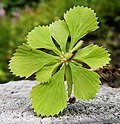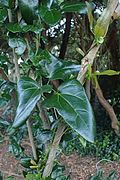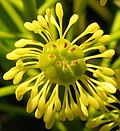Top Qs
Timeline
Chat
Perspective
List of basal eudicot families
From Wikipedia, the free encyclopedia
Remove ads
The basal eudicots are a group of 13 related families of flowering plants in four orders: Buxales, Proteales, Ranunculales and Trochodendrales.[1][a] Like the core eudicots (the rest of the eudicots), they have pollen grains with three colpi (grooves) or other derived structures,[4] and usually have flowers with four or five petals (sometimes multiples of four or five, sometimes reduced or fused).[5] Unlike other eudicots, they sometimes have flowers with petals in twos or multiples of two.[6]
The basal eudicots include trees, shrubs, woody vines and herbaceous plants.[7] Cultivars of Buxus are used for hedges and topiary, and the high-quality wood is commonly used for decorative carvings and musical instruments.[8] The sacred lotus is the national flower of India and Vietnam, and the waratah is the floral emblem of the Australian state of New South Wales.[9] The opium poppy, Papaver somniferum, a source of morphine, was cultivated thousands of years ago in Mesopotamia.[10] Macadamia nuts are mainly grown in Hawaii and Australia.[11]
The orders Dilleniales and Gunnerales are basal within the core eudicots. Species of Gunnerales often have serrate (serrated) leaves, with flowers similar to those of Buxales. The epidermis and hairs on species of Dilleniales are often full of silica.[12][13]
Remove ads
Glossary
From the glossary of botanical terms:
- annual: a plant species that completes its life cycle within a single year or growing season
- basal: attached close to the base (of a plant or an evolutionary tree diagram)
- climber: a vine that leans on, twines around or clings to other plants for vertical support
- deciduous: shedding or falling seasonally, as with bark, leaves, or petals
- glandular hair: a hair tipped with a secretory structure
- herbaceous: not woody; usually green and soft in texture
- perennial: lives for more than two years
- unisexual: bearing only male or only female reproductive organs (i.e. not bisexual)
- woody: hard and lignified; not herbaceous[14]
The APG IV system is the fourth in a series of plant taxonomies from the Angiosperm Phylogeny Group.[2]
Remove ads
Dilleniales and Gunnerales families
Remove ads
Basal eudicot families
Remove ads
See also
Notes
- The taxonomy (classification) in this list follows Plants of the World (2017)[1] and the fourth Angiosperm Phylogeny Group system.[2] Total counts of genera for each family come from Plants of the World Online.[3] (See the POWO license.) Extinct taxa are not included.
- Some plants were named for naturalists (unless otherwise noted).
Remove ads
Citations
References
Wikiwand - on
Seamless Wikipedia browsing. On steroids.
Remove ads

































